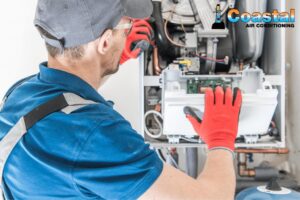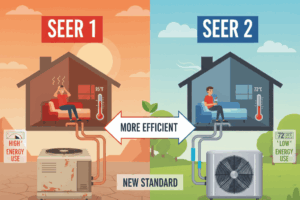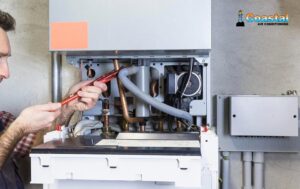You expect warm air when you turn on your furnace. So, when cold air rushes out instead, it’s not just surprising—it’s a problem that needs attention. The good news is, many causes of a furnace blowing cold air can be resolved without a service call. Others require help from a qualified HVAC technician.
In this guide, we’ll walk through common reasons your furnace may be blowing cool air instead of heat. We’ll also show you which ones you can fix yourself and when it’s time to call in a professional.
1. Thermostat Settings Are Misconfigured
It might seem obvious, but your furnace may not be the problem at all. Check your thermostat. Incorrect thermostat settings are one of the most frequent causes of cool air from the vents.
Make sure the thermostat is set to “heat,” not just “on” or “fan.” When set to “fan,” the blower runs constantly—even when the burners aren’t producing warm air. As a result, you’ll feel cold air circulating through your home.
Also, verify that your temperature setting is higher than the current room temperature. Some digital thermostats need new batteries periodically—so if it’s unresponsive or working incorrectly, replacing the batteries might fix the issue.
Tip: If you recently had a power outage, your thermostat may have reset to default settings. Recheck all configurations after a power loss.
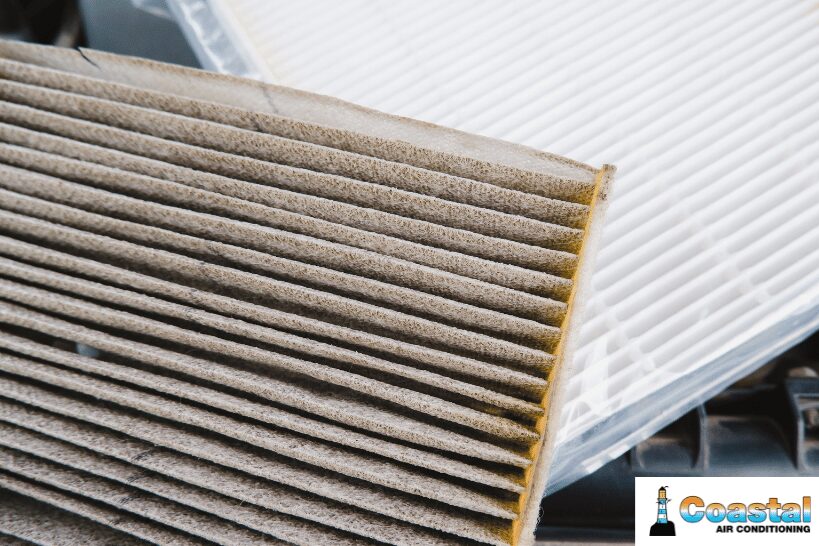
2. Clogged Air Filter
Your furnace depends on airflow to maintain a steady temperature. A clogged air filter can block that airflow, causing the system to overheat. When it overheats, a safety switch may shut off the burners to prevent damage or a fire. However, the blower fan may keep running, so you get cold air coming out of your vents.
To check if your air filter is clogged, locate the filter (usually near the return air duct or inside the furnace cabinet), pull it out, and hold it up to the light. If you can’t see light coming through, replace the filter. This is one of the easiest steps, and it helps your HVAC system run more efficiently, too.
Recommendation: Replace your air filter every 1 to 3 months, especially during peak heating and cooling seasons.
3. Pilot Light Is Out (For Older Furnaces)
If you still have an older gas furnace with a standing pilot light, it must stay lit for the heat to work. When the pilot light goes out, the burners can’t ignite. As a result, your fan may blow unheated air throughout your home.
You can check the status of the pilot light by opening the furnace access panel. If it’s out, you may be able to relight it by following the steps in your furnace’s manual. Usually this means turning the gas valve to “off,” waiting a few minutes, then switching to “pilot” and using a long match or lighter.
If the pilot light continues to go out, it could be due to a dirty sensor, weak thermocouple, or a faulty gas valve. These are all issues where a trained HVAC technician should step in.
4. Gas Supply Problems
A furnace can’t heat your home without gas. If you’re getting cold air, first check that your furnace’s gas valve is open. It’s usually a small red or yellow handle near the gas line. If it’s closed or partially closed, your burners may not light.
Also, be aware that gas interruptions can happen. Your gas provider might be performing maintenance or dealing with an outage. If other gas appliances like your stove or water heater also aren’t working, call your utility company—not an HVAC pro.
If you smell gas, leave the house immediately and contact your utility provider or 911. Don’t use electrical switches or lighters near a suspected leak.
Safety Note: Never attempt to adjust or tamper with gas lines if you’re unsure. Always call a professional.
5. Dirty or Faulty Flame Sensor
Modern gas furnaces use an electronic flame sensor to detect whether the burners have ignited. If it doesn’t sense a flame, it shuts the gas valve to prevent unburned gas from entering the house.
Over time, the flame sensor can build up residue from combustion. When it gets dirty, it can’t detect the flame—even if one is present. This causes the system to shut off the burners, leaving the blower to circulate unheated air.
Some symptoms include short cycling (where the furnace starts and stops quickly) and a noticeable drop in warm air.
Cleaning a flame sensor involves removing it, lightly sanding it with an emery cloth, and reinstalling it. If you’re not confident in your ability to safely do this, contact an HVAC technician.
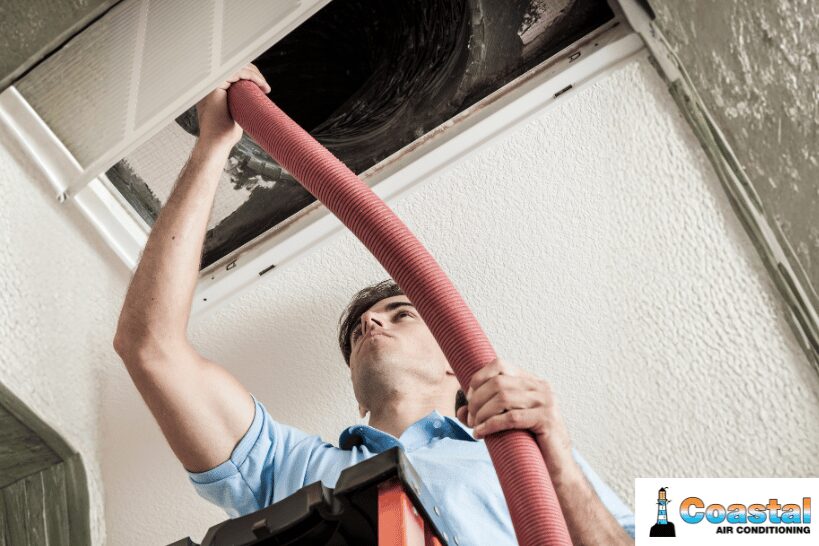
6. Leaky or Damaged Air Ducts
Even when your gas furnace is working properly, problems in your air ducts can lead to cool air in your living spaces. Ducts carry warm air from your furnace to each room. If there are leaks, cracks, or disconnected sections, that warm air can escape, pulling in unheated or cold air from attics, crawl spaces, or basements.
Watch for these common signs:
- One room is much colder than others.
- Whistling or blowing sounds from the walls.
- Higher-than-usual energy bills.
Ductwork inspection and repair is something that requires access to your attic or crawl spaces and may involve sealing or replacing sections of duct. An HVAC technician has the tools and experience necessary to do this safely and correctly.
7. Furnace Is Still Warming Up
You may notice a short burst of cold air right after your system starts. This isn’t always a sign something’s wrong. When a heating cycle begins, a small amount of cool air inside the ducts may get pushed out before warm air follows.
Allow your furnace two to three minutes to begin producing warm air. However, if cold air continues long after the system has started—or if it cycles on and off without ever producing heat—it’s time to take a closer look at one of the other problems listed above.
Related Article: Furnace Not Turning On? Here’s How to Fix It Fast
When to Call an HVAC Technician
Some furnace problems need professional diagnosis. Call a qualified HVAC technician if:
- You’ve checked the thermostat, air filter, and pilot light, but still have no heat.
- You suspect a failed component like a gas valve or flame sensor.
- Your gas furnace is short cycling or not igniting at all.
- You smell gas or notice signs of a gas leak.
- Your air ducts need repair or sealing.
Handling gas components, electrical parts, or internal components without proper know-how can be dangerous. A pro can identify the root cause, fix it correctly, and help prevent the issue from returning.
Don’t Settle for Cold Air—Know When to Take Action
A furnace blowing cold air doesn’t always mean major repairs are needed. Many cases come down to something simple—like thermostat settings or a clogged air filter. But when the problem runs deeper, your best bet is to call a trusted HVAC company who can get your heating system back to normal quickly and safely.
Staying on top of regular HVAC maintenance—like replacing your air filter and checking the thermostat seasonally—goes a long way toward avoiding bigger problems. If your furnace is giving you trouble, don’t ignore it. Addressing early signs keeps your home warm, your energy bills manageable, and your HVAC system working for years to come.
Need help? Contact Coastal Air Conditioning. We’re here when you need reliable service without the stress.

